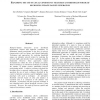Free Online Productivity Tools
i2Speak
i2Symbol
i2OCR
iTex2Img
iWeb2Print
iWeb2Shot
i2Type
iPdf2Split
iPdf2Merge
i2Bopomofo
i2Arabic
i2Style
i2Image
i2PDF
iLatex2Rtf
Sci2ools
DSRT
2005
IEEE
2005
IEEE
Exploring the Use of Local Consistency Measures as Thresholds for Dead Reckoning Update Packet Generation
Human-to-human interaction across distributed applications requires that sufficient consistency be maintained among participants in the face of network characteristics such as latency and limited bandwidth. Techniques and approaches for reducing bandwidth usage can minimise network delays by reducing the network traffic and therefore better exploiting available bandwidth. However, these approaches induce inconsistencies within the level of human perception. Dead reckoning is a well-known technique for reducing the number of update packets transmitted between participating nodes. It employs a distance threshold for deciding when to generate update packets. This paper questions the use of such a distance threshold in the context of absolute consistency and it highlights a major drawback with such a technique. An alternative threshold criterion based on time and distance is examined and it is compared to the distance only threshold. A drawback with this proposed technique is also identif...
| Added | 24 Jun 2010 |
| Updated | 24 Jun 2010 |
| Type | Conference |
| Year | 2005 |
| Where | DSRT |
| Authors | David J. Roberts, Damien Marshall, Rob Aspin, Séamus McLoone, Declan Delaney, Tomás Ward |
Comments (0)

